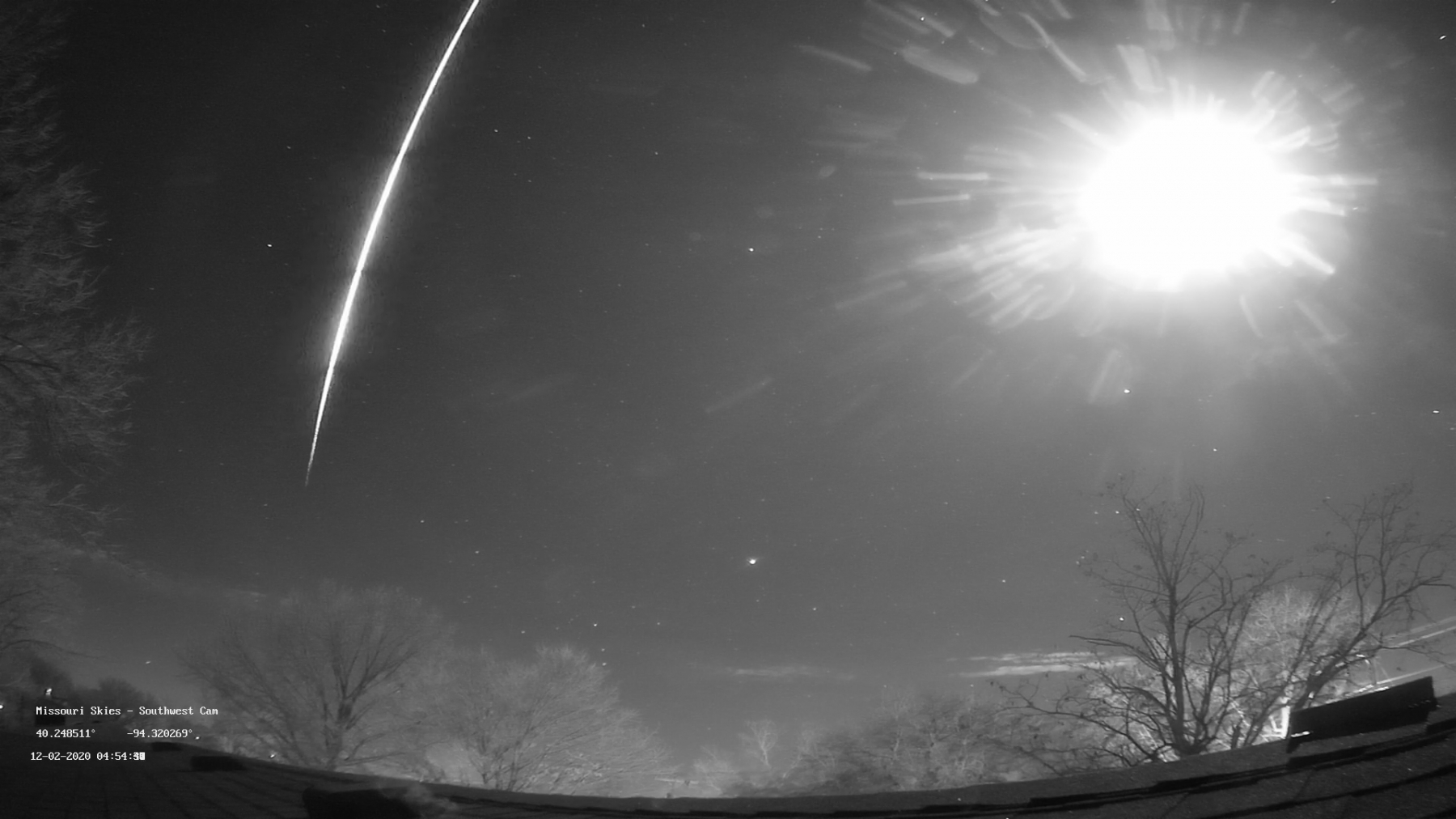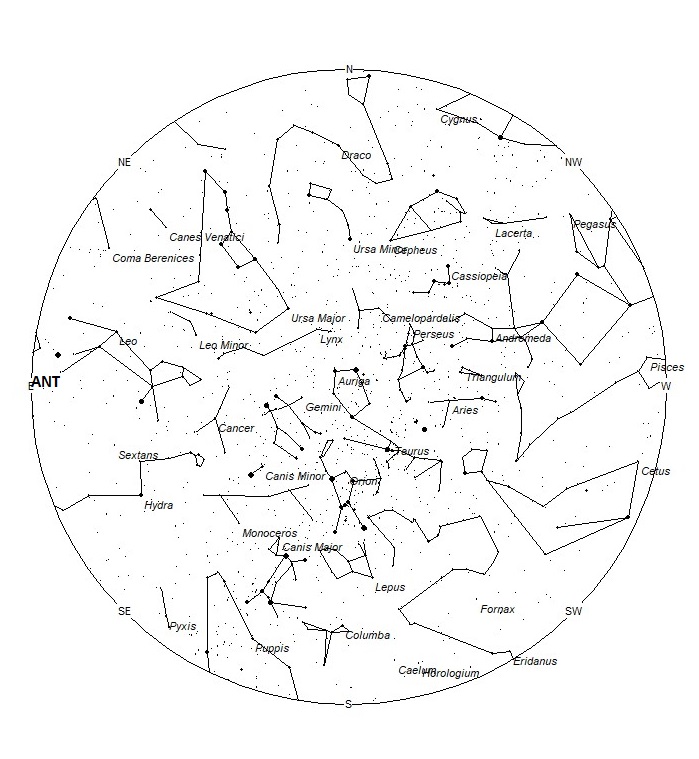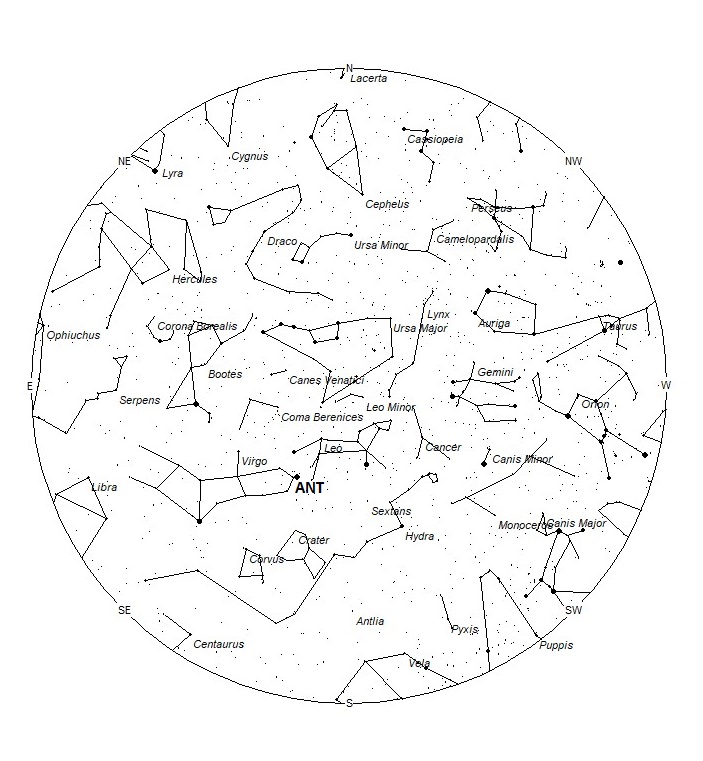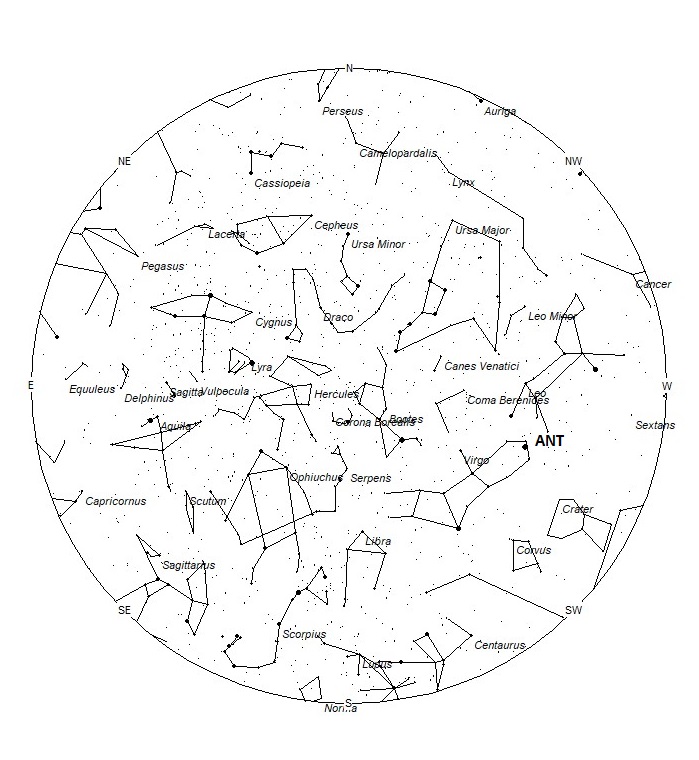 Daniel Bush captured this brilliant fireball from Albany, Missouri, USA, on December 2, 2020, at 10:54 UT (4:54am CST). For more on this event, visit https://fireball.amsmeteors.org/members/imo_view/event/2020/7309 Credit Daniel Bush.
Daniel Bush captured this brilliant fireball from Albany, Missouri, USA, on December 2, 2020, at 10:54 UT (4:54am CST). For more on this event, visit https://fireball.amsmeteors.org/members/imo_view/event/2020/7309 Credit Daniel Bush.As seen from the northern hemisphere, March is the slowest month of the year for meteor activity. No major annual showers are active and only a few very weak minor showers produce activity this month. The sporadic rates are also near their annual minimum so there is not much to look forward to this month except for the evening fireballs that seem to peak this time of year as seen from the northern hemisphere. This could be due to the fact the Antapex radiant lies highest above the horizon this time of year during the evening hours. From the southern hemisphere, activity from the Centaurid complex begins to wane with only the weak activity visible from Norma and perhaps others nearby areas. At least southern sporadic rates are still strong to make the late summer viewing a bit more pleasurable.
During this period, the moon reaches its full phase on Saturday February 27th. This is the worst time of the month to view meteor activity as the bright moon will lie above the horizon all night long. Only the brightest meteors will be visible under such conditions, which will persist all week long. The estimated total hourly meteor rates for evening observers this week is near 2 as seen from mid-northern latitudes and 3 as seen from tropical southern locations (25S). For morning observers, the estimated total hourly rates should be near 3 as seen from mid-northern latitudes (45N) and 6 as seen from tropical southern locations (25S). The actual rates will also depend on factors such as personal light and motion perception, local weather conditions, alertness, and experience in watching meteor activity. Rates are reduced during this period due to moonlight. Note that the hourly rates listed below are estimates as viewed from dark sky sites away from urban light sources. Observers viewing from urban areas will see less activity as only the brighter meteors will be visible from such locations.
The radiant (the area of the sky where meteors appear to shoot from) positions and rates listed below are exact for Saturday night/Sunday morning February 27/28. These positions do not change greatly day to day so the listed coordinates may be used during this entire period. Most star atlases (available at science stores and planetariums) will provide maps with grid lines of the celestial coordinates so that you may find out exactly where these positions are located in the sky. A planisphere or computer planetarium program is also useful in showing the sky at any time of night on any date of the year. Activity from each radiant is best seen when it is positioned highest in the sky, either due north or south along the meridian, depending on your latitude. It must be remembered that meteor activity is rarely seen at the radiant position. Rather they shoot outwards from the radiant, so it is best to center your field of view so that the radiant lies at the edge and not the center. Viewing there will allow you to easily trace the path of each meteor back to the radiant (if it is a shower member) or in another direction if it is sporadic. Meteor activity is not seen from radiants that are located far below the horizon. The positions below are listed in a west to east manner in order of right ascension (celestial longitude). The positions listed first are located further west therefore are accessible earlier in the night while those listed further down the list rise later in the night.
These sources of meteoric activity are expected to be active this week.
Details of each source will continue next week when observing conditions improve.
| SHOWER | DATE OF MAXIMUM ACTIVITY | CELESTIAL POSITION | ENTRY VELOCITY | CULMINATION | HOURLY RATE | CLASS |
| RA (RA in Deg.) DEC | Km/Sec | Local Standard Time | North-South | |||
| Anthelion (ANT) | – | 11:28 (172) +03 | 30 | 01:00 | 1 – 1 | II |
 American Meteor Society
American Meteor Society



On the night of 02/27/21 I was looking out the door of my bedroom (admiring the full moon) and I saw what I thought was a “green shooting star”…. it was sooo bright, soooo green, and it looked to close.
Hello!
I saw a big green meter looking west from downtown Toronto On Friday the 26th at 10:07 pm! Not sure if anyone else saw but wanted to let you guys know!
I have been seeing these green fireballs as well Carly! So beautiful! Don’t forget to report it here: https://fireball.amsmeteors.org
Good luck meteor watching!
I saw a bright green, fairly low on the horizon, that must have broken in two it became two meteors. It was amazing!
I saw a massive bright orange fireball from Luton, UK
Maria and All,
You and more than 750 other witnesses have reported this fireball. Check out:https://fireball.amsmeteors.org/members/imo_view/event/2021/1202
Just Saw a meteor or comment down know which one falling from sky in in the west direction I saw this object in eastern Oklahoma while walking my dog it was green with a white light thought it was a plane crash.
On 2/27/2021, I saw a very bright, quite long lasting, thick white streak that appeared to break apart right before disappearing. I was excited that I happened to be outside and facing the right direction. I live in southeast Wyoming. I was facing north and it went from east to west. It wasn’t an ordinary shooting star.
I’ve seen 1 today, 7:30 ET over Windsor, Canada /Detroit, US.
I just witnessed a meteorite fall from the sky at nearly straight down. It was first a thin light line/tail and then turned into a very bright white ball and fizzled approx. 100 ft from the ground. 1 was approx. 1/4 mile away, bit with tall trees in the way of seeing the actual landing place. The time was approz 9:40 central time in South eastern Wisconsin
Last night March 3rd 2021 I was coming home at about 6:30 p.m. mountain standard Time and I saw a fireball east of Colorado springs a bunch of other people saw it as well. it was neat
Charleston about 7pm EST saw a fireball looking East heading north west. Largest / closest I’ve ever seen! Absolutely beautiful.
My daughter seen two light blue fire balls at the same time about 3:30 in the afternoon . We live in Grants Pass Oregon and they were toward the east on 3/11/21 .